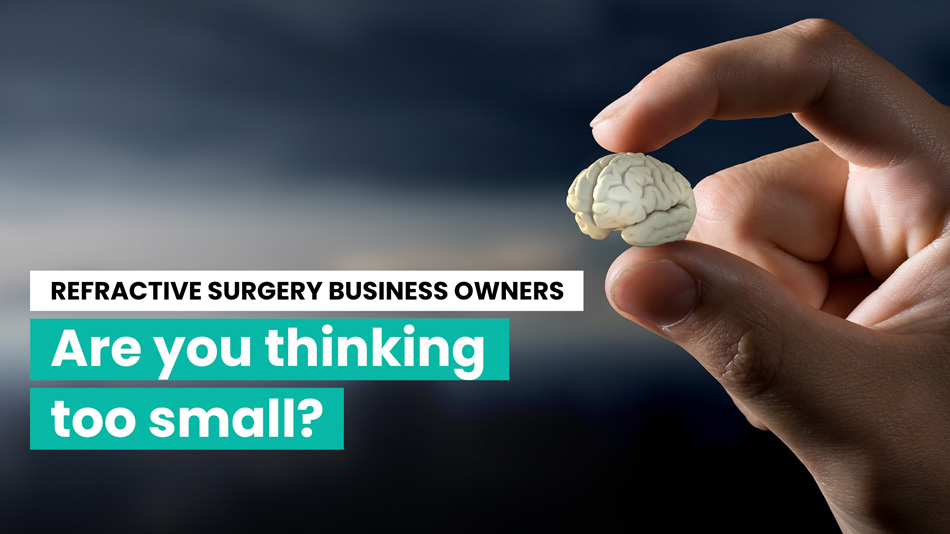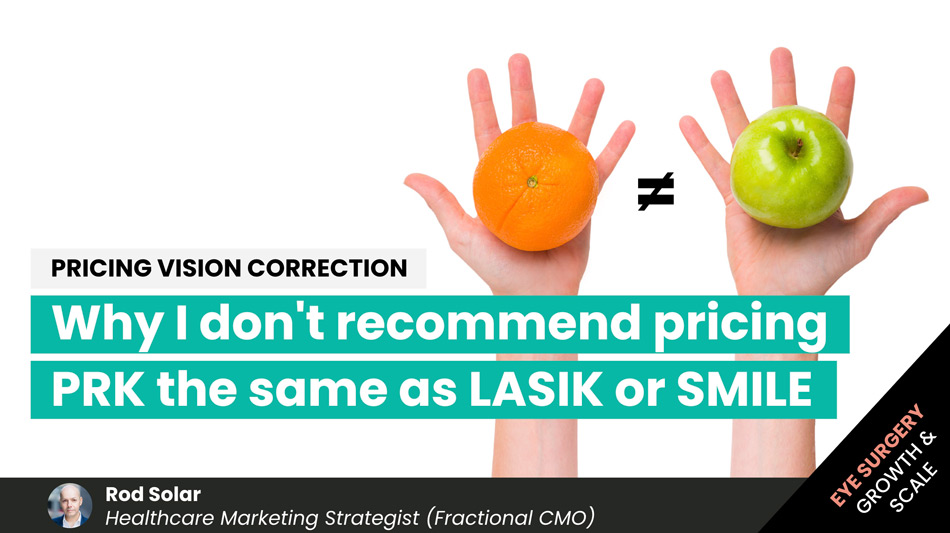
Will Millennials save laser eye surgery?
We had a spirited discussion at the “Meet the Experts” panel discussion on Marketing at the European Refractive Laser Surgery Conference in Paris last month. The presenters mainly focused on promoting ReLEx SMILE and how Millennials are the primary target market. The mood was buoyantly optimistic. The panellists agreed that, if only marketed to correctly, Millennials will adopt ReLEx SMILE just like their parents (the Baby Boomers) flocked to LASIK in the late 1990s and early 2000s.
I raised the question:
“Millennials have much lower spending power than Baby Boomers and there are fewer Millennials in Europe when compared to Baby Boomers, how will laser eye surgeons continue to increase volume and prices as the market shrinks?”
The panellists disagreed that there was a reason to be concerned. They argued instead that plenty of Millennials had lots of money and were happy to spend on experiences like laser eye surgery (I paraphrase). I didn’t have my statistics to hand to argue the point further comprehensively but decided to dig deeper into this question for myself when I returned to London.
Laser eye surgery, while delivering outstanding outcomes, has been limping along as a product for a decade since the great recession of 2007. It’s been slowly making a comeback while optimistic refractive surgeons await the maturing of the Millennials, the children of the parents who once took up laser eye surgery in droves.
Will it happen? This blog post argues why we believe that the past will not necessarily repeat itself.
LASIK volumes fell off a cliff in 2008
For those new to the story, shortly after refractive surgeons introduced LASIK at the end of the’90s, it peaked in the US in 2007 at about 1.4 million procedures per year. Everything changed in 2008 when the financial crash severely depressed consumer confidence which led to the halving of LASIK procedures over the years until 2016 (about 600,000). Industry watchers suggest that surgical volumes will increase again, but their predictions are modest with Statistica suggesting procedures will rise back to 718,000 in 2020.
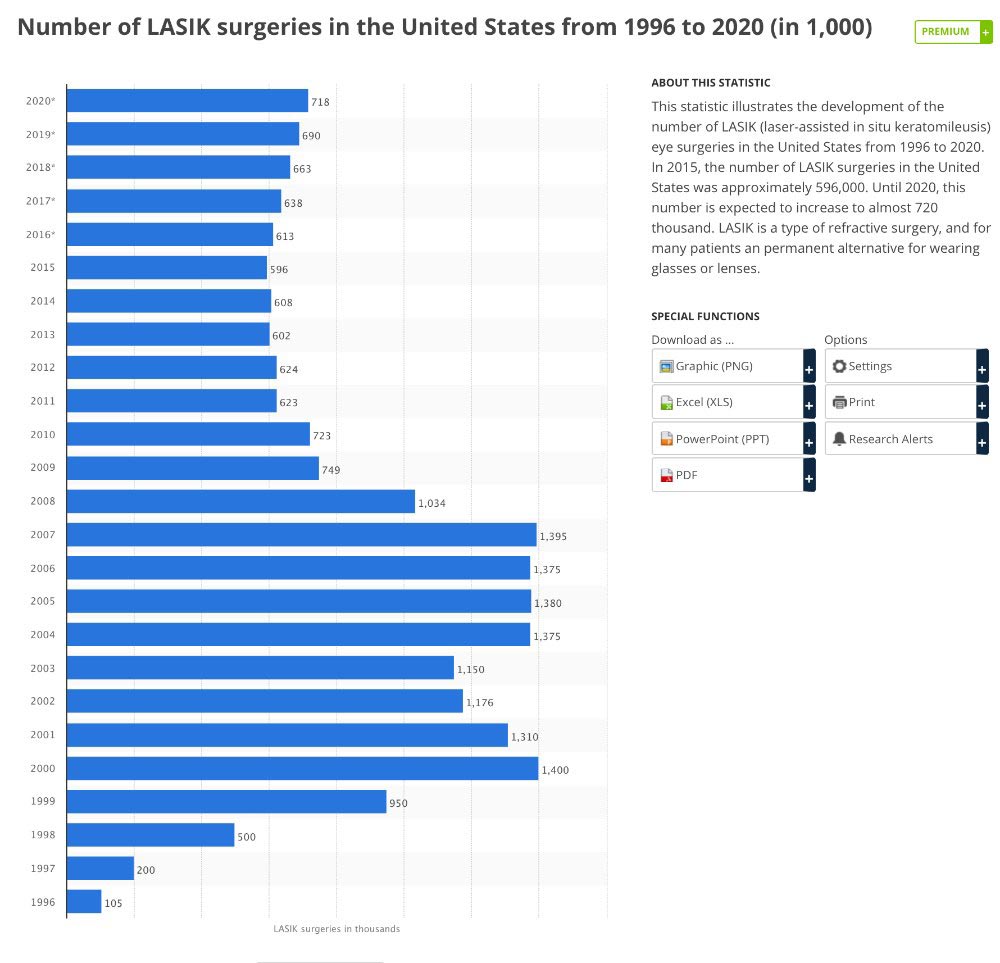
Source: Statistica https://www.statista.com/statistics/271478/number-of-lasik-surgeries-in-the-us/
In late 2016, Marketscope forecasted that “global demand for refractive surgery (laser refractive surgery, presbyopia-correcting surgery, and phakic IOL implantation) is expected to grow at a compounded annual rate of 5.5 percent from 2016 to 2021, with annual procedure volume increasing from 3.8 million to 4.9 million.” Much of this growth will arise in “US, Japan, and some Western European countries”.
With regards to fees, MarketScope forecasts “that average fees for laser refractive surgery will decline at a compounded rate of 0.2 percent due to increasing competition among laser centers and doctors, plus growth in demand in Asia and other emerging markets where laser refractive surgery is lower in price.” They went on to “forecast that some of this decline will be offset by an increase in premium procedure share due to a higher share of femtosecond laser procedures, new advanced ablation patterns, and newer technology adoption.”
The picture in the UK hasn’t been any rosier, with the value of the laser eye surgery sector declining steadily since 2010.
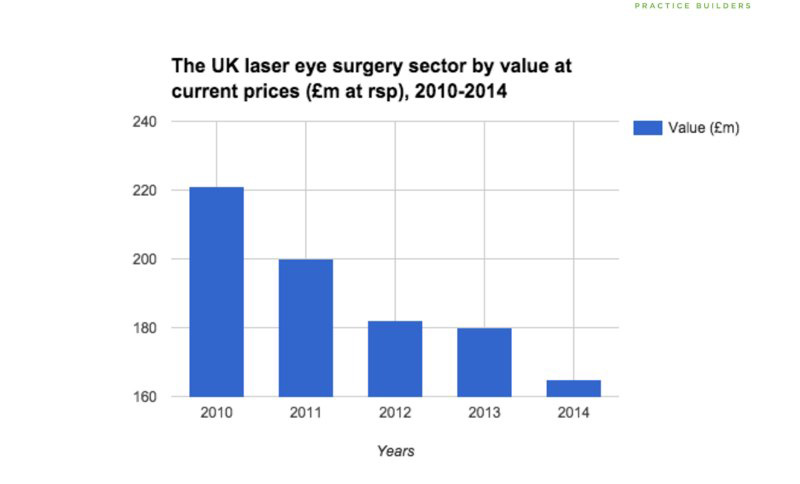
Source: Key Note Ophthalmic Goods and Services Report 2015
UK procedural volumes have either flattened or declined. The value of the industry is reducing because volumes are declining while the average price erodes.
There is a consensus that the price of goods and services increases over time. That is true. But what happened to laser eye surgery prices? They’ve been declining for over a decade. Optician Magazine conducted annual surveys of clinics in the UK laser eye surgery market between 2001 and 2009 and revealed laser eye surgery prices fell between those years.
Laser eye surgery prices stumbled between 2001 and 2009
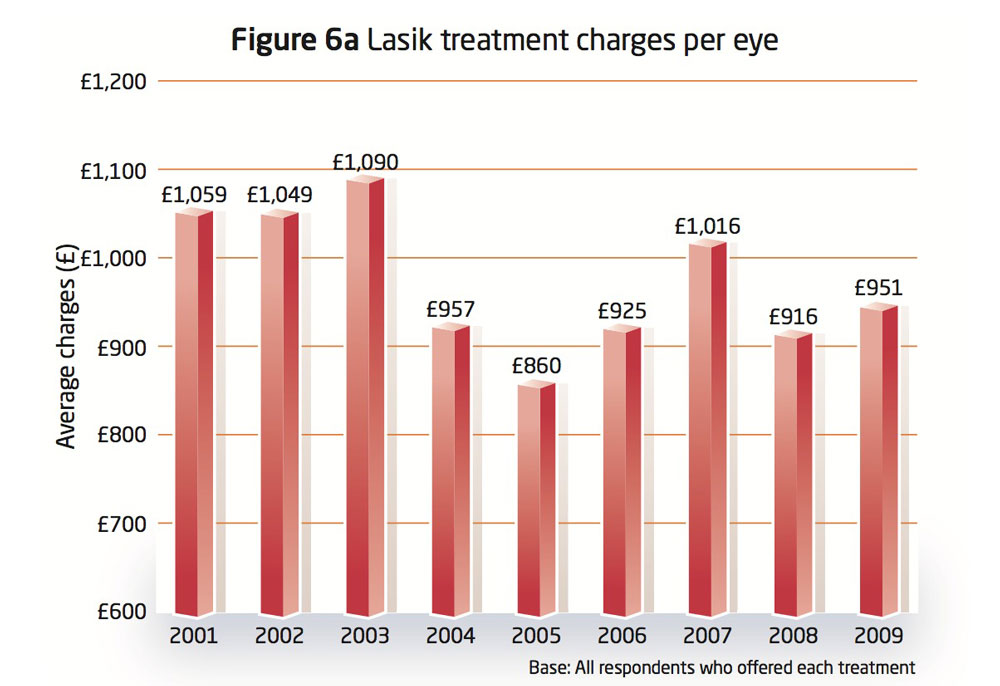
Refractive Surgery Trends, Optician Magazine 2009
UK Inflation over 2001 to 2009 averaged 2.7% a year. In other words, something that cost £1000 in 2001 would cost £1,233 in 2009. The reality for laser eye surgery bucks the trend. What happened?
First, it’s important to note that these charts reflect the average prices for LASIK (as opposed to custom LASIK or femtosecond LASIK) which surgeons price between £100 to £250 more per eye.
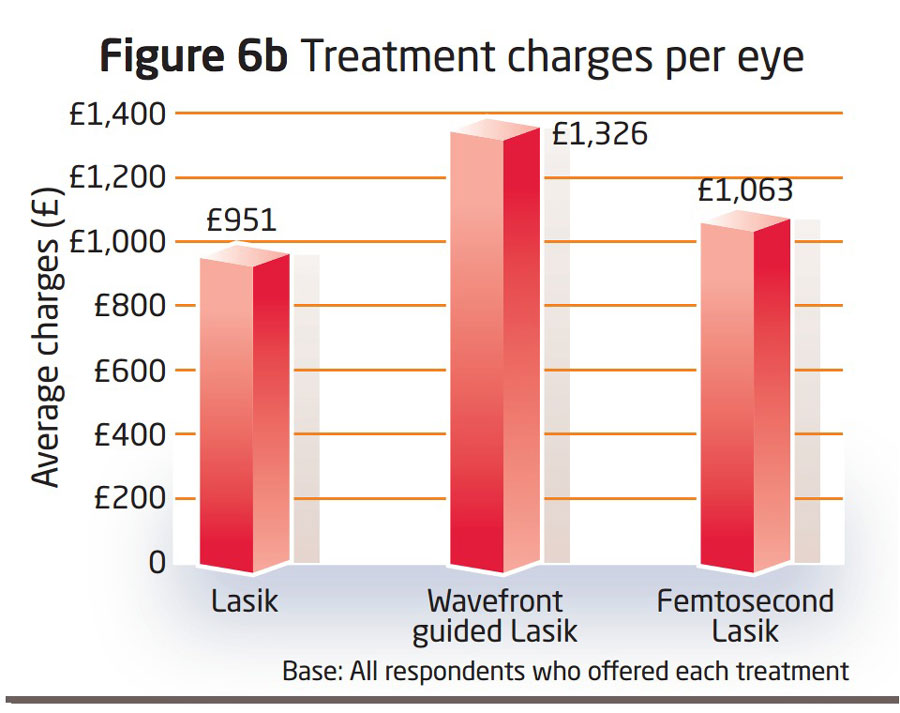
Refractive Surgery Trends, Optician Magazine 2009
One could interpret from the two charts above that the while standard LASIK prices fell during the period, non-standard extras (wavefront-guided and femtosecond LASIK) were sufficiently attractive add-ons to keep LASIK prices relatively stable. There is some truth in that, but it’s not the whole story. What proportion of surgeons charges a single price versus tiered pricing based on technology or refractive error?
Figures in the UK are hard to come by, but in the US, more than 3 out of 4 refractive surgeons (78 percent) said they quote a single price for LASIK and other excimer laser-based procedures for all patients, according to MarketScope’s 2015 Survey of Cataract and Refractive Surgeons.
First, it’s important to note that these charts reflect the average prices for LASIK (as opposed to custom LASIK or femtosecond LASIK) which surgeons price between £100 to £250 more per eye.
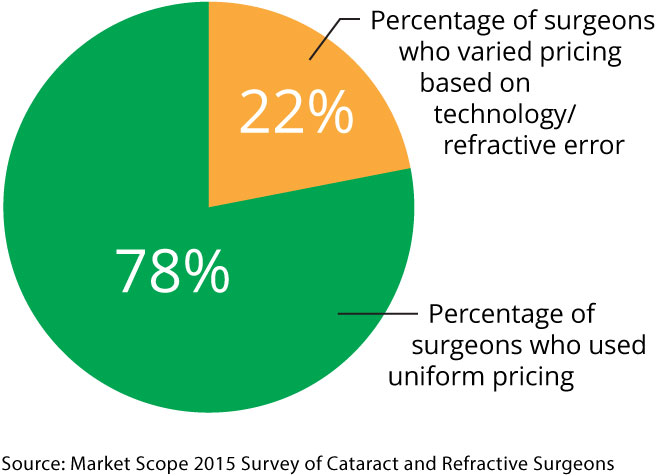
Source: MarketScope
In the US, in 2015, the average price for LASIK and other types of laser vision correction surgery was $2,077 per eye. This figure is slightly lower than the average price in 2014, which was $2,118 per eye. For perspective, MarketScope measured the average price of LASIK to be just above $2000 per eye in 1999! It declined dramatically in 2002 to $1550 per eye and has been (very) slowly recovering every since.
NOTE: The best way to answer that nagging question about practice growth or marketing or patient volume in the back of your mind is to book a free 15-minute compatibility call. Get some options and go away with a clear idea of what’s possible.
Why do laser eye surgery prices remain flat or decline in the first place?
There are a couple of reasons. One reason is that chains of clinics chose to commoditize the procedure by offering it at lower prices compared to those charged by independent clinics and surgeons. The logic most commonly used is that because people fear the LASIK procedure, lowering the price will make them fear it less.
Indeed, it is as preposterous as it sounds.
Eventually, in the UK, many independents chose to join the larger chains in the race to the bottom instead of fighting them on value, thereby depressing the average price for LASIK across the board and repeating the devastatingly destructive pattern observed in the US.
LASIK commoditization is a subject that was explored by Mr Sheraz Daya in his article for Cataract and Refractive Surgery Today Europe: Whatever happened to LASIK (volumes)? He argues, and I agree, that commoditization led to less desirability for the procedure and more dissatisfied patients as a result of upselling extras instead of performing comprehensive examinations for every candidate.
So, will LASIK prices increase back to higher levels now? Will procedural volumes rebound back to the 2008 high watermark levels?
Many believe this will happen and view the Millennials as the generation that will save the LASIK market.
Will Millennials save the LASIK (or laser eye surgery) market?
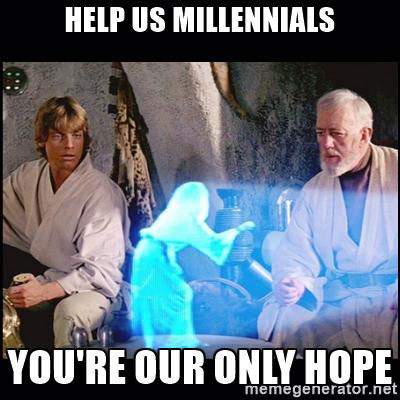
Millenials (people born between 1980 and 2000 – also known as Generation Y) are more known for killing traditional markets – from wine corks to golf, rather than saving them. Still, many hope Millennials will be the next big market that – like their boomer parents – will flock in droves to refractive surgery clinics offering LASIK and SMILE (keyhole LASIK). Why? Bullish surgeons and laser manufacturers look at the numbers:
- The Millennial generation is the biggest in US history (92 million millennials compared to 77 million baby boomers)
- Millennials are entering their peak spending years
- Millennials have come of age in a time of technological change and therefore trust technology more than their parents did
- Millennials are keen to maximise experiences and wellness
Read these quotes from the optimistic Ophthalmology Management article published in 2014 entitled “How Generation Y will save refractive surgery.”
Generation Y is twice as large as Generation X, are in their late 20s and are financially able to afford LASIK,” says Eric Donnenfeld, MD, of Rockville Center, N.Y., and president of ASCRS. Dr. Donnenfeld, and others acknowledge that while the heyday of refractive surgery may not fully return, their refractive-surgery work is vital and will reach consumers with the right mix of quality procedures, patience and marketing.
“The opportunity for LASIK to become even more popular is extraordinary,” Dr. Donnenfeld says. “It comes down to doing a good job in communicating to the patient the value of laser-vision correction, and whether the economy improves”…
Generation Y could turn that equation around, as it offers “great candidates for LASIK,” Mr. Celebrezze says. “The best time to get LASIK is when you are in your early 20s, because this age provides the longest lifetime benefit.”
Generation Y is well equipped to deal with the price issue, too, according to Dr. Jackson. “They can get financing easily,” he says. “Gen X are too overloaded with kids of their own. Baby Boomers are focusing on advanced IOL technology now as they are in the presbyopia years of their lives.”
Dr. Durrie concurs: “The Millennial generation, if they are excellent candidates, get outstanding results. If they have the surgery at 25 instead of 35, 10 years without glasses or contact lenses can pay for the surgery; if that generation adapts, we will see dramatic growth.”
Last year the American Refractive Surgery Council (ARSC) released results of its survey that indicated Generation Y “may be more open to LASIK than were previous generations.”
First, the bad news – Millennials aren’t rich
This optimism all sounds ideal for LASIK, and it’s newer cousin ReLEx SMILE, but there are some big reasons why laser eye surgeons may want to carefully reconsider putting all their eggs in the Gen Y basket. Consider the following statistics from “Spending Power Across the Generations”, a report produced by the Intergenerational Foundation, related to spending power:
The spending power of those 30 and under has declined. For example, people aged 50-74 spend twice as much per year as the under-30s on theatre and cinema tickets.
By 2011, British people aged 65 and over were spending £1.3 billion more on foreign travel than they had been in 1999, while people aged 16-34 were spending £922 less.
People aged 65-74 enjoyed the largest per capita increase in annual spending on food that was bought to be eaten at home during the period of 2000-2010
Restaurant bills also proved to be weighted intergenerationally with the under-30s spending on average of 18% less per capita on meals in restaurants by 2010 than they had in 2000. By contrast, the 65-74s were spending 33% more, and the over-75s were spending 30% more.
Purchases of new cars among those between 65-74 fell by 8% compared to an 80% fall in the under-30s.
In summary, older people have more money to spend than younger people.
There is a popular misconception that seniors are poor. However, the baby boomer generation (which accounts for the majority of the 50+ group) has more disposable income than any generation it follows, or that follows it.
Older generations have enjoyed more favourable economic conditions during the first part of the 21st century, and younger people are struggling with lower disposable incomes due to high unemployment, unprecedented student loan debts, small or frozen wages for workers in general, and high housing costs.
Below we’ve created a chart from European statistics that display the average incomes among different generations in the EU-28 and five selected countries. Judging from this data, it’s clear that in every country we studied, Millennials have less average income than Baby Boomers and Generation X. Generation Xers (those born between 1964 and 1979 – currently aged 38-53) earn more income on average than either Millennials and Baby Boomers in two of the markets, Germany and the United Kingdom. One of the economic challenges that Generation Xers commonly face is where to direct their discretionary income – which is from where funds for luxuries like LASIK come. Generation Xers are in their peak earning and spending years, and they are dealing with the most financial concerns, including saving for retirement, mortgages, loans, and credit card debt. Millennials, on the other hand, are often still single and renting, yet still, they have less discretionary income until they reach their mid-30s. Marriage, having children and owning a home impact discretionary spending and this might be one reason cash-strapped Millennials are putting these things off.
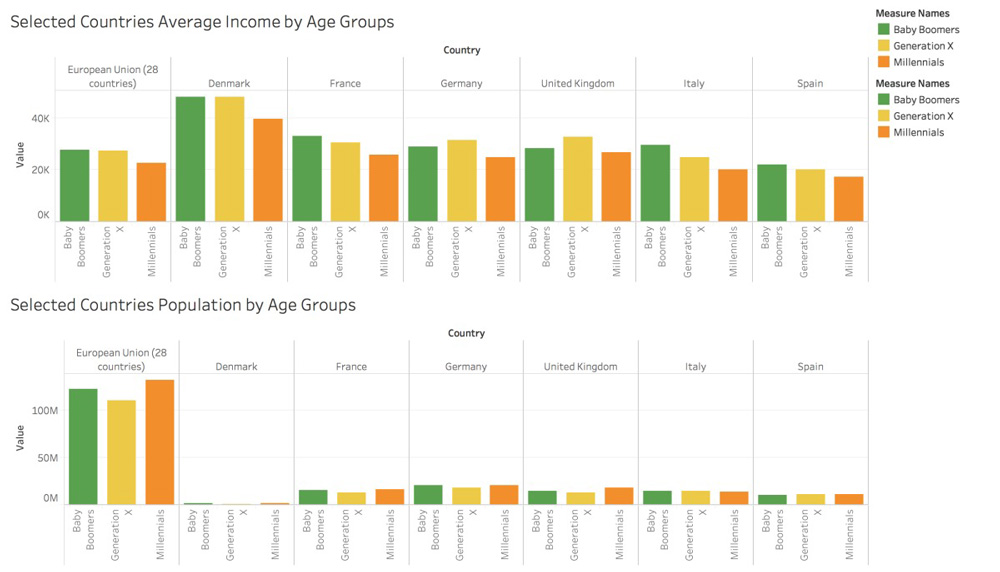
Source: Eurostat
The good news is that there are more Millennials than there are Baby Boomers in the E-28. This pattern isn’t seen however in Italy or Spain. This overall trend is sure to continue, however, as Baby Boomers die off at a higher rate (between 1 in 112 – 1 in 42 annually) than Millennials do (1 in 1908 – 1 in 1215 annually).
Time will tell if the larger relative group of Millennials with lower incomes will be sufficient to bring back LASIK’s fortunes. There are however other issues that may cause Millennials to be less than ideal targets for laser eye surgery.
Millennials aren’t just an echo of the Baby Boomers; they have fundamentally different values
Most of the discussion surrounding marketing to millennials focuses on using new technology (e.g. social media) to reach them where they live. Marketing to Millennials is in itself a flawed construct – millennials don’t want to be marketed to, they prefer to talk through their options with their peers and parents and then arrive at a decision after doing their research, usually online.
In the US, there are 92 million Millennials, compared to 61 million Generation Xers, and 77 million Baby Boomers. The median age of Millenials is 27 (in 2017).
It’s true that Millennials are digital natives. They are the heaviest users of IM/Chat applications, the biggest downloaders of music/video online, the largest social media users, and are least likely to watch cable TV, preferring to watch video online.
With that said, Millennials are more complex than their technology preferences. We believe that the most successful companies attempting to attract Millennials will not only reach them where they live but also focus on what they most value.
Millennials will be the first generation to be worse off than their parents. Lower levels of employment and smaller incomes have left younger Millennials with less money than previous generations. Nonetheless, they will be expected to pay for the problems their parents created (e.g. a hopelessly underfunded social welfare system that must meet the demands of an ageing population, global debt, a delicately precarious financial system that might collapse at any moment, and climate change). Fortunately, making money isn’t a primary concern for them, when compared to a good work/life balance, leadership and progression opportunities, flexibility, learning, and a sense of meaning from work.
While they are accustomed and unafraid of new technology, they trust other people (mainly traditional authorities like doctors) about half as much as their Boomer parents did. Millennials value authenticity and doing good much more than their parents did, and they’ll smell out self-interest or fakeness in a heartbeat. Raised in a time of recession and economic hardship, Millennials choose to “live for today” with regards to spending, as opposed to investing in the future. Their spending philosophy is less practical and more impulsive than their parents.
Will Millennials adopt laser eye surgery as their parents did? In 2017, the oldest Millennials are 37; the youngest is 17. Some laser eye surgeons, like Richard Lindstrom of Minnesota Eye Consultants, says:
“The critical patients for LASIK today are the millennials…” he said. “The mean age for LASIK is 39, and the millennial is not there yet. They wear glasses until their teens; then, they wear contact lenses into their 30s. Then, they’ll move on to LASIK.”
Lindstrom suggests that “The LASIK market will expand when the medial (sic) Millennials are in their 30s, which is about four years away, around the year 2020.”
Sounds reasonable, if Millennials were to follow the patterns their parents set. However, Millennials aren’t following their parent’s examples in other large spending areas. For example, the peak home-buying years are 25 to 45 year old. A growing number of Millennials (aged 18-34) are choosing to live at home with their parents. But it’s not because they don’t want homes. 93% (more than any other generation) of Millennial renters say they plan to buy a home some day. 60% of Millenials rent, which makes them less able to access credit. Millennials are also putting off significant life milestones like getting married or having children. The median age for marrying in the 2010s was 30 years of age. In the 1970s, it was 23 years of age. Millennial women are putting off parenthood too. 70% want to get married someday, and 74% want children some day. Millennials are reluctant to buy lots of things their parents did. Why purchase a car when you can ride-share? When it comes to health and wellness, Millennials favour prevention over cure. They are dedicated to wellness, devoting time and money to exercising and eating right. Their active lifestyle influences trends in everything from food and drink to fashion. (Sources for all stats)
For better or worse, Millennials are not an echo of their Boomer parents. They are different, and there’s no guarantee they’ll follow in their parent’s footsteps when it comes to LASIK or any form of laser eye surgery.
Key takeaways
We’d like to conclude this post with some important points:
- LASIK volumes declined ten years ago and are slowly building back, but may never again reach benchmark levels
- LASIK prices are around the same level they were ten years ago
- A reliable way to increase LASIK prices is through technological add-ons (e.g. wavefront, femtosecond, ReLEx SMILE)
- Millennials are widely hoped to be the generation that might bring back LASIK’s fortunes
- There is plenty of evidence to suggest that Millennials will not follow in their Boomer parent’s footsteps when it comes to adopting LASIK
What do we advise?
Should you abandon LASIK as a procedure for those aged between 20 and 45? No, we think there is still lots of room to serve those Millennials that will wish to have LASIK or ReLEx SMILE. However, the days of relying on one broad group to supply all the necessary demand for a LASIK practice are going away. You’ll need to not only approach Millennials differently through non-traditional marketing (e.g. social media, inbound marketing and referral marketing) but you’ll also need to:
- geographically locate your service in places where Millennials live and work
- adjust your service and premises to suit Millennial preferences and values better
- message to appeal to Millennial values
Furthermore, we advise laser eye surgeons not to ignore the reliable source of LASIK patients from the past who are now presbyopic and to whom solutions for their presbyopia will appeal (e.g. PRESBYOND). We see a lot of innovation and movement in the presbyopic market space, which includes presbyopic laser, refractive lens replacement, and intracorneal solutions. These areas of practice, combined with LASIK marketing to Millennials, will provide a healthy balance of markets for the vision correction practice of the future.
NOTE: The best way to answer that nagging question about practice growth or marketing or patient volume in the back of your mind is to book a free 15-minute compatibility call. Get some options and go away with a clear idea of what’s possible.
About the author

Rod Solar
Founder & Scalable Business Advisor / fCMO
Rod Solar is a co-founder of LiveseySolar and a Scalable Business Advisor for its customers. Rod mentors and coaches eye surgery business CEOs/Founders and their leadership teams to triple their sales, double their profit, and achieve their “ideal exit”.
Related Posts
Meet our Co-Founders
We’re passionate about helping leaders of high-quality, growth-minded practice owners double their practice revenue

Rod Solar
Founder & Scalable Business Advisor
For over 20 years, I’ve helped ophthalmology entrepreneurs scale their private practices. I specialise in doubling revenue within three years by offering a proven framework, hands-on experience, and a team of experts who implement what works. We take the guesswork out of growth and scale, so you can focus on delivering exceptional patient care while maximising the value of your business.
LiveseySolar completely transformed the way we were approaching this… We’ve gone from having just the dream of having a practice to having a practice up and running with people making inquiries and booking for procedures… It’s extremely pleasing. We feel lucky we connected with LiveseySolar.
— Dr Matthew Russell, MBChB, FRANZCO, specialist ophthalmic surgeon and founder of VSON and OKKO

Laura Livesey
Founder & CEO
I’m the co-founder & CEO of LiveseySolar. I’ve developed powerful eye surgery marketing systems that increase patient volumes and profits for doctors, clinics, and hospitals, since 1997.
Rod and Laura know as much about marketing surgery to patients as I know about performing it. They are an expert in the field of laser eye surgery marketing. They know this industry inside out. I believe that they could help many companies in a variety of areas including marketing materials, sales training and marketing support for doctors.
— Prof. Dan Reinstein, MD MA FRSC DABO, founder of the London Vision Clinic, UK







